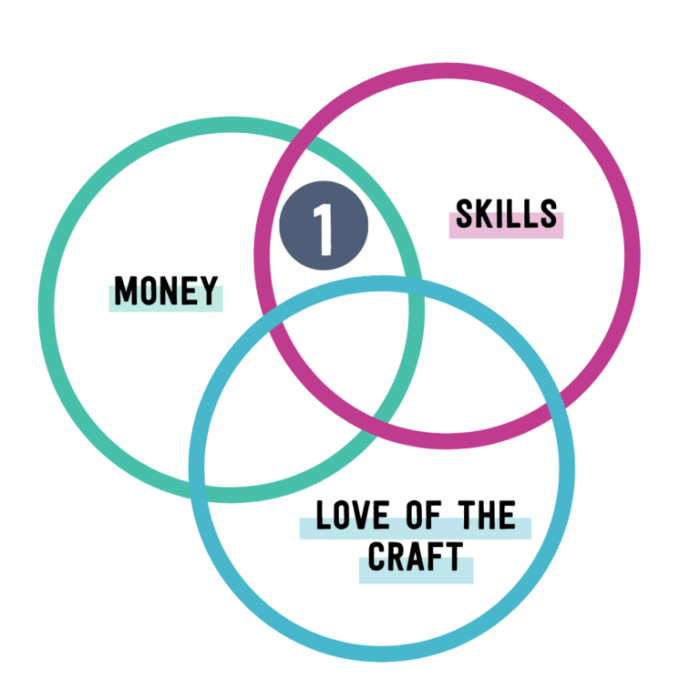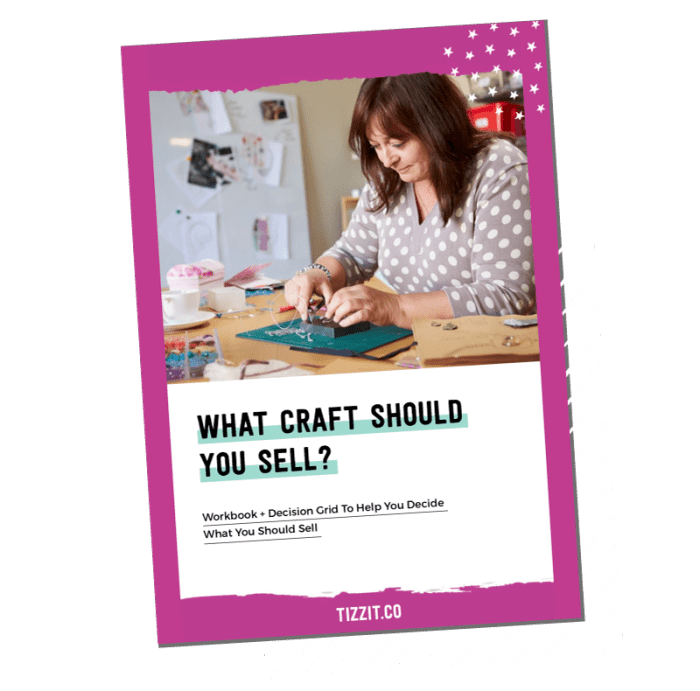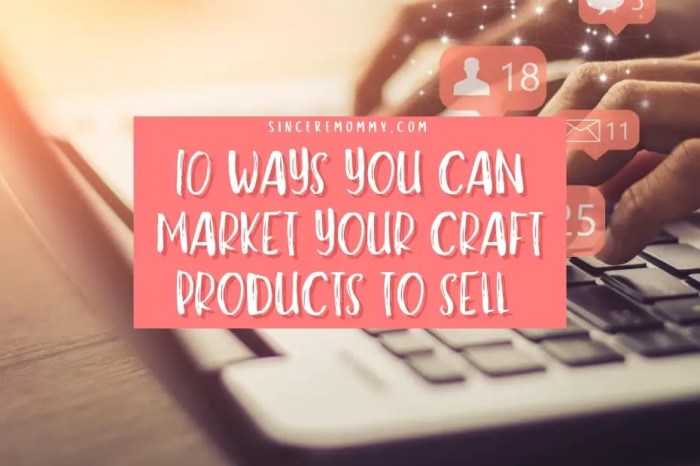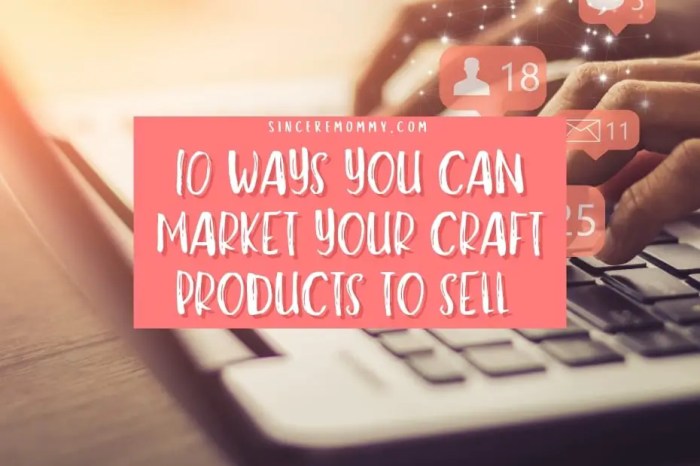You’ve got the skills, the passion, and the handmade goods – now it’s time to turn your crafting dreams into a thriving business! But how do you get your awesome creations in front of the right people? That’s where marketing comes in, and it’s not as complicated as you might think.
This guide is your roadmap to building a successful brand, reaching your target audience, and making some serious dough with your handmade products.
We’ll dive into everything from understanding who your ideal customer is to crafting a killer brand identity that screams “buy me!” We’ll also explore the best marketing channels for your handmade goods, from social media to online marketplaces and even direct sales.
Get ready to unleash your inner marketing guru and watch your business take off!
Understanding Your Target Audience

Knowing your target audience is like having a map to a hidden treasure – it guides you directly to your ideal customers. It’s not about selling to everyone; it’s about finding the perfect fit for your handmade creations.
Identifying Your Ideal Customer
To effectively market your handmade products, you need a clear picture of who your ideal customer is. This involves understanding their demographics, interests, and purchasing habits.
- Demographics:This includes factors like age, gender, location, income level, and education. For example, if you make handcrafted jewelry, your target audience might be women aged 25-45 with an interest in fashion and a disposable income.
- Interests:Understanding your customer’s interests helps you tailor your marketing message. Do they enjoy vintage style, bohemian vibes, or modern minimalism? Their interests will influence their buying decisions.
- Purchasing Habits:Where do they shop? Do they prefer online marketplaces, brick-and-mortar stores, or direct-to-consumer websites? Knowing their purchasing habits helps you reach them effectively.
Understanding Their Needs and Desires
Once you know who your ideal customer is, it’s time to delve into their needs and desires. What are they looking for in a handmade product?
- Quality:Handmade items are often associated with high quality and craftsmanship. Your target audience likely values this aspect.
- Uniqueness:Handmade products are inherently unique and one-of-a-kind. This appeals to customers who seek something special and different.
- Storytelling:The story behind your product can be a powerful selling point. Share your inspiration, process, and passion with your customers.
- Sustainability:Many customers are drawn to handmade items because they are often made with sustainable materials and ethical practices.
- Personalization:The ability to customize or personalize a handmade product can be a huge draw for your target audience.
Communicating with Your Target Audience
Effective communication is key to reaching your target audience. Here are some ways to connect with them through your marketing efforts:
- Social Media:Use platforms like Instagram, Pinterest, and Facebook to showcase your products and engage with potential customers.
- Content Marketing:Create blog posts, videos, and other content that provides value to your target audience and showcases your expertise.
- Email Marketing:Build an email list and send regular newsletters with updates, promotions, and exclusive content.
- Online Marketplaces:List your products on platforms like Etsy, Amazon Handmade, and Shopify.
- Local Events:Participate in craft fairs, farmers markets, and other local events to connect with customers in person.
Crafting Your Brand Identity

Your brand identity is the face of your handmade business. It’s what makes you stand out from the crowd and attracts customers who love what you create. Think of it as your unique personality that you’re sharing with the world.
Developing a Unique Brand Name and Logo
A strong brand name and logo are the foundation of your brand identity. They should be memorable, relevant to your products, and visually appealing.
- Brainstorming:Start by listing words that describe your products, your style, and the feeling you want to evoke. Think about your target audience and what resonates with them.
- Keep it Short and Simple:A catchy name that’s easy to remember and pronounce is key.
Crafting your income from handmade goods is like discovering a secret garden – it takes time and effort to cultivate, but the rewards are totally worth it. You can find inspiration and learn new techniques by checking out The Secret Garden , a website filled with tips and tricks for crafting and gardening.
Once you’ve got your garden blooming, it’s time to share your creations with the world and start turning your passion into profit!
- Check for Availability:Make sure the name and logo you choose aren’t already taken.
- Visual Appeal:Your logo should be visually appealing and reflect the essence of your brand. It can be a simple design or something more elaborate, but it should be easily recognizable.
Creating a Brand Story
Your brand story is the narrative that connects with your target audience on a deeper level. It’s the reason why people should choose your products over others.
- What’s Your Passion?:What inspired you to start crafting? What are your values and beliefs?
- The Craft Behind the Product:Highlight the handmade nature of your products and the skill and care that goes into each piece.
- Connect with Your Audience:Use storytelling to connect with your target audience on a personal level.
Designing a Visual Identity
Your visual identity includes your color palette, typography, and imagery. It’s how you visually represent your brand and create a cohesive look across all your marketing materials.
Crafting your income with handmade goods is like crafting a killer joke book – you gotta find your niche and hit that sweet spot. Just like No Pun Intended Volume Too (The Last of Us Joke Books) brings the laughs, your handmade products need to stand out and make people say, “Wow, I gotta have that!” So get creative, find your audience, and watch your income grow, one awesome creation at a time.
- Color Palette:Choose colors that reflect your brand personality and resonate with your target market.
- Typography:Select fonts that are legible, appropriate for your brand, and reflect the tone of your message.
- Imagery:Use high-quality images that showcase your products and tell your brand story.
Marketing Strategies for Handmade Products

It’s time to get your handmade goods out there and into the hands of eager customers! But with so many options, how do you choose the right marketing strategies? Let’s dive into some of the most effective ways to promote your unique creations.
Online Marketplaces
Online marketplaces provide a convenient platform for showcasing your handmade products to a wider audience. They offer a built-in customer base, streamlined payment processing, and established marketing tools.
- Etsy:Etsy is a go-to platform for handmade and vintage goods. It boasts a large and engaged community of buyers, making it a prime choice for artisans of all types. While Etsy charges listing fees and transaction fees, it’s a proven platform for reaching a dedicated audience.
- Amazon Handmade:Amazon’s Handmade program offers a global reach and a trusted brand name. You can tap into Amazon’s extensive customer base and leverage its established logistics and customer service infrastructure. However, competition on Amazon can be fierce, and it’s important to optimize your product listings for visibility.
- Shopify:Shopify allows you to create your own online store and customize your brand experience. You have more control over your branding and pricing, but you’ll need to handle marketing and customer service yourself. Shopify is a good option for those who want a more independent online presence.
Social Media
Social media platforms offer a powerful way to connect with potential customers, build a community around your brand, and drive traffic to your online store.
- Instagram:Instagram is a visual platform that’s perfect for showcasing your handmade products. Use high-quality photos and engaging captions to capture attention and tell the story behind your creations.
- Pinterest:Pinterest is a visual search engine that’s great for driving traffic to your online store.
Create visually appealing pins that showcase your products and link them to your website or online marketplace listings.
- Facebook:Facebook is a versatile platform that can be used for promoting your products, engaging with customers, and building a community.
So you’re thinking about selling your awesome handmade stuff, huh? That’s cool, but before you start hustling, you might want to check out some seriously mind-blowing facts that could help you level up your game. Like, did you know that the average person spends over 10 hours a day staring at a screen?
Yeah, that’s why it’s important to make your products stand out. You can find tons of cool and surprising facts in Fascinating Facts for Inquisitive Minds 1587 Mind-Boggling Facts About Science History Pop Culture & Beyond! Fun & Interesting Trivia Book For Curious People.
Once you’ve got your head full of knowledge, you can use it to create a killer marketing strategy and make your handmade goods the hottest thing since sliced bread!
Consider running targeted ads to reach a wider audience.
Direct Sales
Direct sales allow you to interact with customers in person, build relationships, and provide personalized service.
- Craft Fairs and Markets:Craft fairs and markets provide an opportunity to showcase your products to a targeted audience of craft enthusiasts. You can interact with customers directly, answer questions, and build brand awareness.
- Pop-Up Shops:Pop-up shops offer a temporary retail space where you can sell your products and create a buzz around your brand.
They can be a great way to test the waters in a new location or introduce a new product line.
- Local Businesses:Partner with local businesses to sell your products in their stores or offer workshops or classes. This can provide you with access to a new customer base and build relationships within your community.
Book Review

The book, “The Etsy Seller’s Handbook: Everything You Need to Know to Start and Run a Successful Etsy Business” by Sarah Swenson, is a comprehensive guide that covers everything from setting up your Etsy shop to marketing your handmade products.
Swenson, an experienced Etsy seller herself, provides a practical and insightful approach to building a thriving business on the platform.
Key Takeaways
The book is organized into three sections: Getting Started, Running Your Business, and Marketing Your Products. The first section covers essential topics such as choosing the right products, setting up your Etsy shop, and pricing your items. The second section delves into inventory management, customer service, and legal considerations.
The final section focuses on various marketing strategies to reach potential customers and grow your business.
Strengths
Swenson’s writing style is clear and concise, making the book easy to understand and follow. The book is packed with practical advice and actionable steps that can be implemented immediately. Swenson also provides numerous real-life examples and case studies, illustrating the concepts discussed.
The book’s strengths include:
- Comprehensive coverage of all aspects of running an Etsy shop.
- Practical and actionable advice.
- Numerous real-life examples and case studies.
- Clear and concise writing style.
Weaknesses
While the book is comprehensive, it does not cover every aspect of running an Etsy shop. For example, it does not delve into the nuances of using social media for marketing or the importance of building a strong brand identity.
Additionally, the book’s focus on Etsy may limit its applicability to those selling their products on other platforms. The book’s weaknesses include:
- Limited coverage of social media marketing and brand identity.
- Focus on Etsy may limit its applicability to other platforms.
Personal Opinion
Overall, “The Etsy Seller’s Handbook” is a valuable resource for anyone interested in starting or growing an Etsy business. The book provides a solid foundation for understanding the platform and its features, as well as practical advice on running a successful shop.
While it may not cover every aspect of online selling, it offers a comprehensive overview of the essential elements of running an Etsy business.
“This book is a must-read for anyone serious about selling on Etsy. It’s packed with practical advice and actionable steps that can help you take your business to the next level.”
Sarah Swenson
Wrap-Up

So there you have it – a blueprint for turning your handmade creations into a thriving business! Remember, marketing your products isn’t about being pushy or salesy; it’s about building authentic connections with your audience and showcasing the unique value of your work.
With a little creativity, strategy, and a sprinkle of hustle, you can turn your passion into a profitable business that makes you proud.
Question & Answer Hub
How do I find my target audience?
Think about who would love your products and why. Consider their age, interests, hobbies, and where they hang out online. Social media is a great place to research and see what kind of content resonates with your potential customers.
What are some low-cost marketing strategies?
Social media is your friend! Use free platforms like Instagram, Pinterest, and Facebook to share your work, connect with customers, and run contests. You can also offer freebies, run email marketing campaigns, and collaborate with other crafters.
Should I sell on Etsy or a website?
It depends! Etsy is great for reaching a wide audience of craft lovers, but you’ll pay fees. A website gives you more control but requires more effort to build traffic. Consider starting with Etsy and then launching your own site once you have a solid following.
How can I create engaging content?
Show off your process! Share behind-the-scenes glimpses of your craft, highlight the unique details of your products, and tell your brand story. Be authentic, use high-quality photos and videos, and don’t be afraid to experiment with different content formats.

